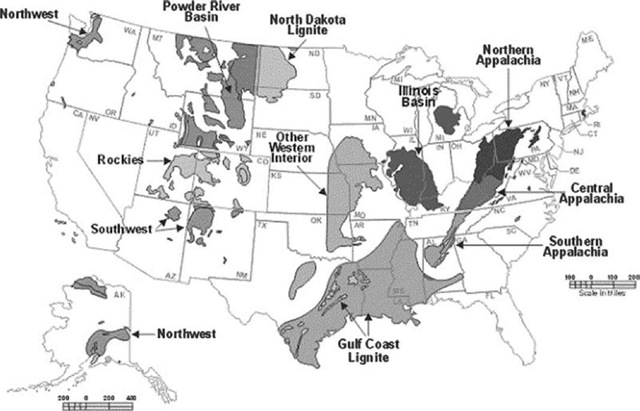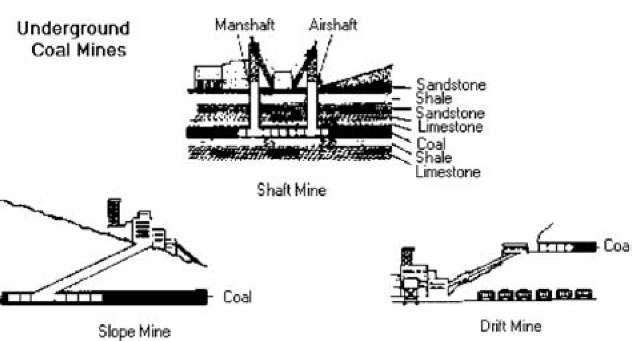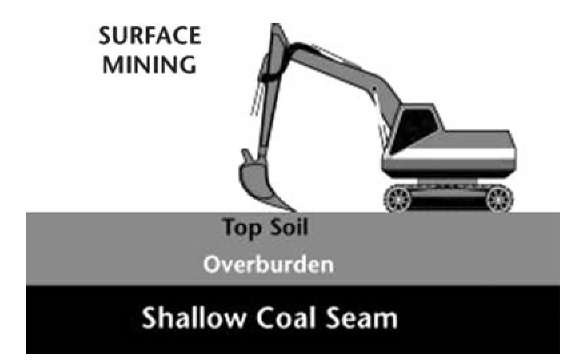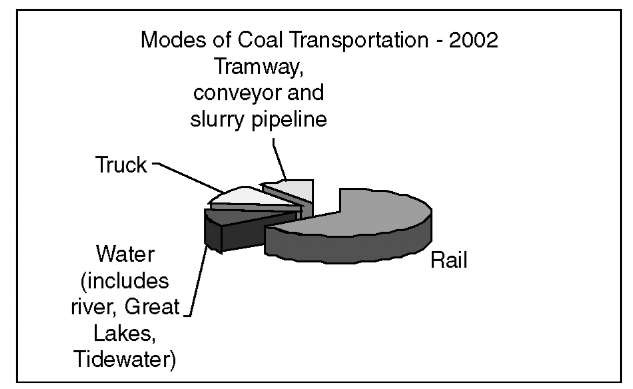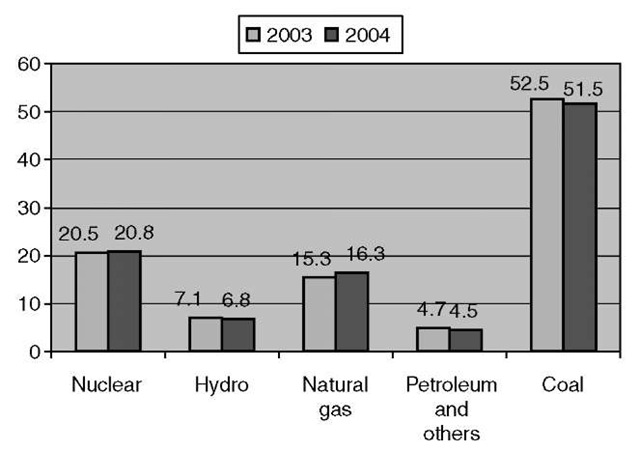Abstract
The United States has approximately 275 billion tons of coal resources in the ground, enough to last more than 200 years at current rates of consumption. Coal ranks in the United States are (from lowest to highest) lignite, subbituminous, bituminous, and anthracite. Estimated recoverable reserves of coal are located in 32 states, and mining currently takes place in 26 of them. Coal is mined in underground and surface mines. Coal is transported from the mines to the ultimate users by conveyer belt, truck, barge, ship, train, or coal slurry pipeline and sometimes by multiple methods. More than 50% of the electricity generated in the United States comes from coal-fired power plants. Electric utilities and industrial users are the largest consumers of coal.
INTRODUCTION
The United States has approximately 275 billion tons of coal resources in the ground, enough to last more than 200 years at current rates of consumption. Coal constitutes 95% of the fossil energy reserves in the United States. Half of the recoverable coal reserves in the world are in China, the United States, and the former Soviet Union.[1]
These estimated coal reserves are generally characterized by coal rank. The coal ranks in the United States are (from lowest to highest) lignite, subbituminous, bituminous, and anthracite. Estimated recoverable reserves of coal are located in 32 states, and mining currently takes place in 26 of them. Coal deposits occur in additional states, but either reserve tonnages have not been estimated or physical conditions are not conducive to mining. Coal is mined in underground mines and in surface mines. Coal is transported from the mines to the ultimate users by conveyer belt, truck, barge, ship, train or coal slurry pipeline, and sometimes by multiple methods. More than 50% of the electricity generated in the United States comes from coal-fired power plants. Electric utilities and industrial users are the largest consumers of coal.[2]
RANKS OF COAL
Coal results from geologic forces having altered plant materials in different ways. The four coal types are derived from peat, which is the first stage in the formation of coal. Peat is partially decomposed plant material. The four types or ranks of coal are lignite, subbituminous, bituminous, and anthracite.[3] The rank of a coal refers to the degree of metamorphosis it has undergone. The longer the organic materials comprising the coal have been buried, along with the amounts of pressure and heat imposed, the greater is its conversion to coal.
Lignite is the lowest rank of coal and is often referred to as brown coal. It has the lowest heating value of any of the four categories of coal [4,000-8,300 Btu/lb (A British thermal unit (Btu) is the amount of heat needed to raise the temperature of 1 lb of water 1 °F)]. It is brownish-black and has a very high moisture (sometimes as high as 55%) and ash content, and cannot be transported very long distances economically. About 8% of the coal produced in the United States is lignite, and most of it is in Texas and North Dakota. Lignite is primarily used as a fuel for electricity generation.
Subbituminous coal ranges from dull dark brown, soft and crumbly, to bright jet black, hard and relatively strong. Although it has a heating value higher only than lignite, averaging 8,400-8,800 Btu/lb in the Powder River Basin (PRB) of Wyoming, there are plentiful reserves of subbituminous coal in the West and in Alaska. Although this coal has a moderately high moisture content (20%-30%), the PRB coal resources in Wyoming and Montana have a lower sulfur content than many bituminous coal reserves and, thus, burn more cleanly. More than 90% of subbituminous coal production comes from the PRB. More than 40% of the coal produced in the United States is subbituminous.
Bituminous coal, often called soft coal in Europe, is the most common type of coal used for the generation of electricity in the United States. It is a dense coal, usually black and sometimes dark brown. This coal has a heating value from 10,500 to 15,000 Btu/lb. The primary use of bituminous coal—and all U.S. coal—is as “thermal” or steam coal, consumed mostly for electricity generation. Bituminous coal also has properties that allow it to be used as metallurgical coal for the steel and iron industries. Bituminous coal accounts for about one-half of U.S. coal production.
Anthracite is the hardest coal (often referred to as hard coal), is brittle, has a high luster, and gives off the second greatest amount of heat when it burns (averaging 12,500 Btu/lb). It is low in volatile matter and has a high percentage of fixed carbon. Anthracite accounts for a small amount of the total coal resources in the United States. It is found mainly in Pennsylvania and is generally used for space heating. Since the 1980s, anthracite refuse or mine waste has been used to generate electricity.[4]
COAL BASINS IN THE UNITED STATES
The large majority of coal in the contiguous United States is found in the Appalachian, Interior, and Western coal regions. These regions are identified in Table 1 and Fig. 1. The characteristics of some typical kind of coals are shown in Table 2. Coal varies significantly from mine to mine and from region to region, even within the same classification (e.g., bituminous).[5]
The Appalachian coal region contains the largest deposit of high-grade bituminous coals in the United States. It is generally divided into three parts. Anthracite and bituminous coals are found in northern Appalachia, which includes the bituminous coal deposits found in the states of Pennsylvania, Maryland, Ohio, and northern West Virginia, and the anthracite fields of eastern Pennsylvania. The bituminous coals found in the central Appalachian area of southern West Virginia, Virginia, northern Tennessee, and eastern Kentucky include deposits that are low in sulfur and highly desirable as a fuel for electricity generation. The Alabama and southern Tennessee coal deposits that are characterized as southern Appalachia have been used primarily in the steel industry through history.
The Interior Basin coals, in general, contain a lower heating value than Appalachian coals, with higher sulfur content. Mining primarily is found today in the Illinois Basin states of Illinois, Indiana, and western Kentucky. In the Illinois Basin, most coal with lower chlorine content has already been mined, and most of the desirable remaining coal will need to be mined in deep underground mines in the future. Bituminous coal deposits are found in other states in the region, including Michigan, Iowa, Missouri, Nebraska, Kansas, Arkansas, Oklahoma, and part of Texas.
Fig. 1 Coal regions and coal fields.
Lignites in the Gulf Coast region are found in Alabama, Mississippi, Louisiana, Texas, and Arkansas. Some of these lignites have a moisture content as high as 55% and heating values sometimes lower than 4,000 Btu/lb, which limits their marketability. Some of the Louisiana lignites are similar to those in North Dakota, with a lower moisture content of around 36% and sodium levels of 5%-8%.
Very large deposits of various kinds of coal are found in the Great Plains. Immense deposits of lignite are found in North and South Dakota. The PRB of Wyoming and Montana contains a very large deposit of subbituminous coal.
The Rocky Mountain states of Colorado and Utah contain deposits of bituminous coal, although other coals can be found throughout the region. Coal from the Southwest, primarily from New Mexico, is both bituminous and subbituminous, and is used for electricity generation. All four ranks of coal exist in Washington state, but the majority is subbituminous. Subbituminous coal is produced at the state’s only active mine and is used for electricity generation.
Coal is distributed widely throughout Alaska, differing greatly in rank and geologic environment. Reserves are estimated to be 15% bituminous and 85% subbituminous and lignite. Developed reserves in Alaska are primarily located near the main lines of transportation.1-8-1
METHODS OF MINING
Coal is removed from the earth either through underground mining or surface mining. About two-thirds of current U.S. coal production comes from surface mines.
Underground mining, also referred to as deep mining, is used when the coal is more than several hundred feet underneath the surface of the earth. There are three types of underground mines: drift mines, slope mines, and shaft mines. The type of mine that will be constructed is dependent on the depth of the coal seam and the terrain. Drift mines have horizontal entries into the coal seam from a hillside. Slope mines, which are usually not very deep, are inclined from the surface to the coal seam. Shaft mines are generally the deepest type of mine and have vertical access to the coal seam via elevators that carry workers and equipment into the mine. Some underground mines are more than 2,000 ft underground. These types of mines are shown in Fig. 2.[9]
Surface mining can usually be used when the coal is buried less than 200 ft under the surface of the earth. Large machines remove the overburden—the layers of soil, rock, and other materials that are between the surface of the earth and the highest minable coal seam (see Fig. 3). Then the exposed coal seam is blasted, using explosives, and the coal is removed. Except in the PRB, where a single minable seam may be as thick as 100 ft, most surface mines produce from multiple coal seams, layered within the rock strata. When that is done, the process outlined above is repeated, removing successive layers of rock (called interburden) between mined coal and coal. For a surface mine, the ratio of overburden to the amount of coal removed is called the overburden ratio. Lower ratios mean that the mine is more productive, and the ratios may be lowered by recovering additional coal seams.
In most cases, after the coal has been mined, the materials that had been on the top of the coal are restored,so that the surface on top of the pits can be reclaimed. When the area has been replanted, it can often be used for any purpose that could have occurred before the land was mined: cropland; wildlife habitat; recreation; or offices, homes, and stores. In the case of mountaintop removal mining, which is used primarily in Appalachia, the surface on top of the coal is not restored to its original contour.
Fig. 2 Underground mining.
Fig. 3 Surface mining.
There are several types of surface mines: area, contour, mountaintop removal, auger, and open pit. Area surface mines are usually found in flat terrain and consist of a series of cuts 100-200 ft wide. The overburden from one cut is used to fill in the mined-out area of the previous cut. Contour mining, which occurs in sloping and mountainous terrain, follows a coal seam along the side of a hill. Open pit mining is generally found where the coal seams are thick and the mines can reach depths of several hundred feet.[10]
COAL PRODUCTION
Coal is mined from surface and underground mines in 26 states. More coal is mined in Wyoming than in any other state. Other states with high production include West Virginia, Kentucky, Pennsylvania, and Texas. Table 3 presents coal production by state for 2001 through 2005. The total 2005 production—just over 1 billion short tons of coal—represents more than one-fifth of the world’s coal production.
The Appalachian coal region annually produces about 35% of total U.S. coal production from large underground and small surface mines. West Virginia is the largest coal-producing state in the Appalachian coal region and the second largest in the United States. Coal from this region is used as a power plant fuel to produce electricity, for production of metals, and to export to other countries.
Texas is the largest coal-producing state in the Interior region, almost all lignite for power plants. The Illinois Basin states are the next more significant producers: Indiana, Illinois, and Western Kentucky, respectively. Almost 13% of U.S. coal production is from the Interior region, most produced in midsize surface mines by midsize to large companies.
Wyoming is the largest producing state in the nation, a position it has held for 19 consecutive years as of 2005. Its 2005 level of production was just 11 million tons short of the production of the next five largest coal-producing states combined (West Virginia, Kentucky, Pennsylvania, Texas, and Montana). About 52% of the coal mined in the United States comes from the Western region, with more than 30% from Wyoming alone. The large surface mines in the West are the largest coal mines in the world.[12]
COAL TRANSPORTATION
Coal in the United States moves from the coal basin in which it was mined to its final use by rail, water, truck, tramway, conveyor, or slurry pipeline, or more than one of those modes (so-called multimodal transportation). Power plants that are located near or at a mine and burn coal from that mine are called minemouth power plants. The coal for these plants usually moves from the mine to the power plant by truck, tramway, or conveyor. Coal that has been mixed with a liquid, usually water, is called a slurry and is moved through a pipeline that is called a slurry pipeline. The longest coal slurry pipeline in operation in the United States moved coal 273 mi from Arizona to Nevada until January 1, 2006. (It was closed at that time pending the completion of environmental upgrades at the power plant where it is consumed). More than 65% of coal in the United States is transported for at least part of its trip to market by train.[13]
The primary manner in which coal was transported in 2002 is shown in Table 4. Fig. 4 shows the methods of transportation graphically, demonstrating the strong predominance of rail transportation for moving coal in the United States.
USES OF COAL
The overwhelming majority of coal in the United States is used by the electric utility sector, as shown in Table 5— almost 92% of all of the coal consumed in the United States. Industries and businesses also burn coal in their own power plants to produce electricity. The coal is burned to heat water to produce steam that turns turbines and generators to produce electricity.
Fig. 4 Modes of coal transportation 2002.
Industries across the United States use coal for heat and as a chemical feedstock. Derivatives of coal, including methanol and ethylene, are used to make plastics, tar, synthetic fibers, fertilizers, and medicine. The concrete and paper industries also burn coal. Altogether, industrial customers consume more than 7% of the coal mined in the United States.
Table 3 U.S. coal production by coal-producing region and state 2001-2005 (million short tons)
In the steel industry, coal is baked in hot furnaces to make coke, which is used to smelt iron ore into the pig iron or hot iron needed for making steel. The very high temperatures and the fluxing properties to isolate impurities made possible by using coke give steel the strength and flexibility required for bridges, buildings, and automobiles.
Coal provides more than half of the electricity in this country, as shown in Fig. 5, and in certain areas of the country accounts for about two-thirds of the fuel mix for electric power generation. Natural gas use has increased significantly in recent years, as newer generating facilities over the past decade were almost exclusively natural gas-fired because of formerly lower gas prices, lower emissions, and lower investment costs and lead times.[16] With the passage of recent legislation, including the Clean Air Interstate Rules and the Energy Policy Act of 2005, the federal government has put in place a number of incentives to encourage more use of clean, coal-fired power plants and the use of coal for synthetic natural gas and liquid transportation fuels.
Fig. 5 Share of electric power sector net generation by energy sources 2003 and 2004.
CONCLUSION
Coal is a fossil fuel resource in the United States that serves an important role as a feedstock for providing electricity and fuel and/or feedstock for a variety of industries, including steel and plastics. Railroads move more than half of the coal from the mine to its final destination. Although natural gas usage has increased significantly for providing electricity over the past decade, coal remains the primary fuel for electricity production.
Table 4 Coal transportation in the United States (millions of short tons, 2002)
| Mode of transportation | Tonnage moved by this means | |
| Rail | 685,086 | |
| Water (includes river, Great Lakes, tidewater) | 126,870 | |
| Truck | 138,222 | |
| Tramway, conveyor and slurry pipeline | 99,986 | |
| Total 2002 | 1,051,406 |
Table 5 Coal consumption by sector
| Sector | 2001 | 2002 | 2003 | 2004 | 2005 |
| Electric power | 964.4 | 977.5 | 1005.1 | 1016.3 | 1039.0 |
| Coke plants | 26.1 | 23.7 | 24.2 | 23.7 | 23.4 |
| Other industrial | 65.3 | 60.7 | 61.3 | 62.2 | 60.8 |
| plants | |||||
| Combined heat | 25.8 | 26.2 | 24.8 | 26.6 | 20.6 |
| and power (CHP) | |||||
| Non-CHP | 39.5 | 34.5 | 36.4 | 35.6 | 40.2 |
| Residential and | 4.4 | 4.4 | 4.2 | 5.1 | 5.1 |
| commercial users | |||||
| Residential | 0.5 | 0.5 | 0.5 | 0.6 | 0.6 |
| Commercial | 3.9 | 4.0 | 3.8 | 4.6 | 4.6 |
| Total | 1060.1 | 1066.4 | 1094.9 | 1107.3 | 1128.3 |
1 Fill-in-the-blank programming using standard algorithms
2. Line-by-line custom programming
3. Graphical custom programming.
2 Due to superior productivity, large-scale surface and
3 mmst per year) had productivity higher than other surface mines, and in the next 20 years, they experienced higher rates of productivity growth. In 1983, longwall
4 mines had about the same productivity as other underground mines; however, their productivity growth far outpaced other underground mines in the next 20 years:


